3D Truss Models
-
Version 2.3.3 - 04.17.2019
- Enabled the "Edit Truss Assembly" function for attic trusses (imperial units only).
- Improved formatting of all HTML edit menus: Common, Monopitch, Scissor, Attic.
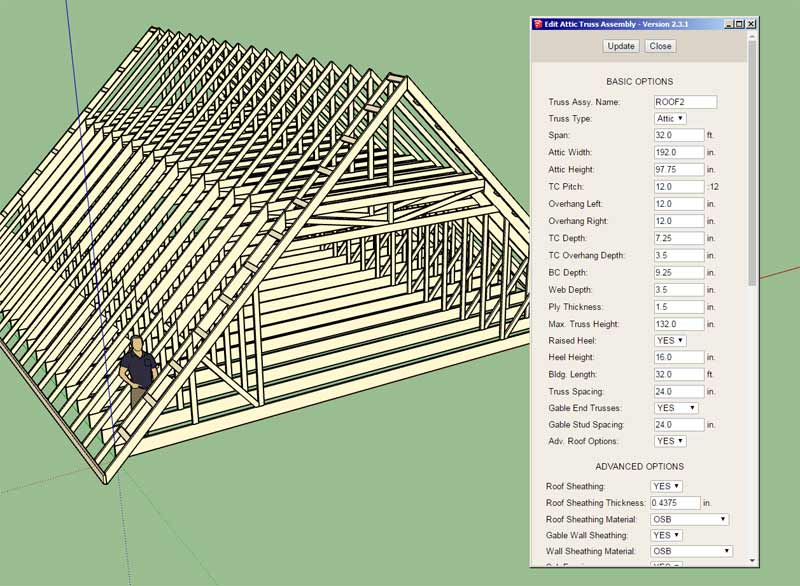
-
When I originally enable hurricane (uplift) ties for the trusses I failed to check to see how things looked with a raised heel when the H2.5A (simpson) tie was used.
In this particular case the tie needs to be flipped around so that it is facing towards the interior rather than the exterior. I've made the correction and added the logic into the code. I will release the fix with the next version:
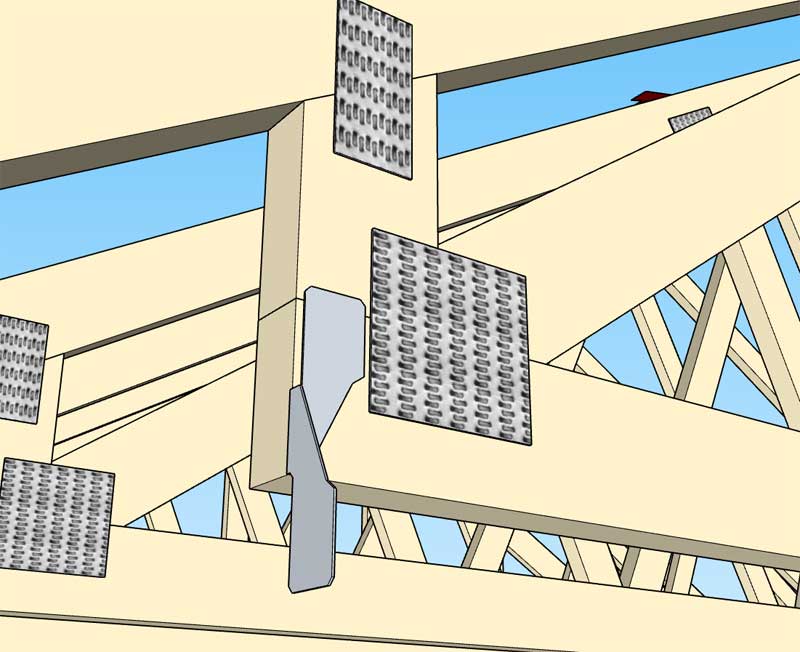
-
Version 2.3.4 - 04.24.2019
- Enabled the "Edit Roof Assembly" function for gable and hip rafter roofs (imperial and metric units).
- Corrected an issue with H2.5A hurricane ties when utilized with raised heel trusses.
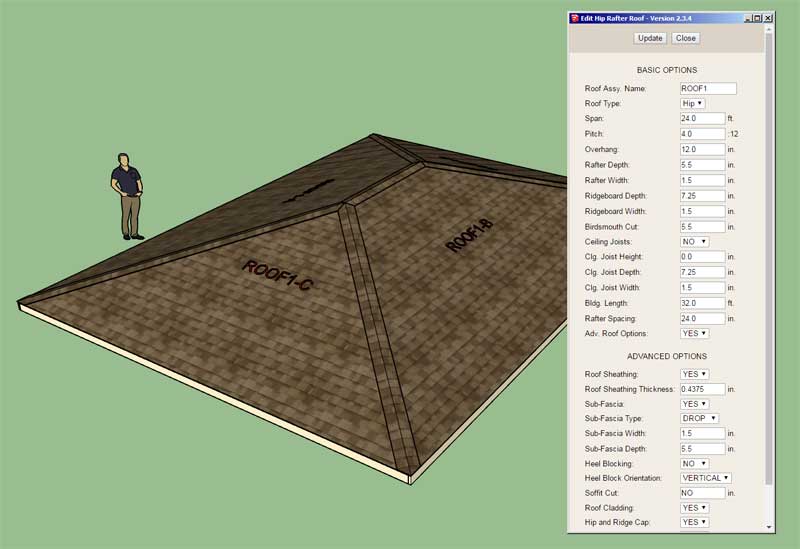
This is a fairly substantial upgrade for the plugin and now gives the user the ability to edit stick framed roofs. Previously only certain truss roofs could be edited.
I still need to enable editing for the other rafter roof types (shed roofs, I-Joist, rafter roofs with glulam beams etc...), but at least I've now got the two most common roof types with full parametrics enabled.
-
This brings me back to some topics I was exploring last year at about this time regarding asymmetric rafter roofs. I will set aside the hip roof for a minute and look at the simple gable roof in continuation of this discussion.
Each side of the roof may have a different pitch. Additionally the top plate height may differ as well as the birdcut. Things tend to get a little complicated when the symmetry is broken.
Basically one can boil it down to a symmetric or asymmetric gable roof. The asymmetric variant will have the following additional parameters:
Roof Type: Symmetric Gable, Asymmetric Gable
Pitch2 - Roof pitch of right side roof
Birdcut2 - Birdcut length of right side of roof
Delta Height - Difference in height between left and right bearing walls (left side is reference)One could even go so far as to define a different rafter depth for the opposite side, as its length may be more or less than its opposite side:
Rafter Depth 2 - Rafter depth on right side of roof.
-
With the asymmetric variant the secondary pitch and bearing height cause the location of roof peak to be off center. In order to draw the roof one must first solve for the location of the roof peak (x direction). The solution is given by:
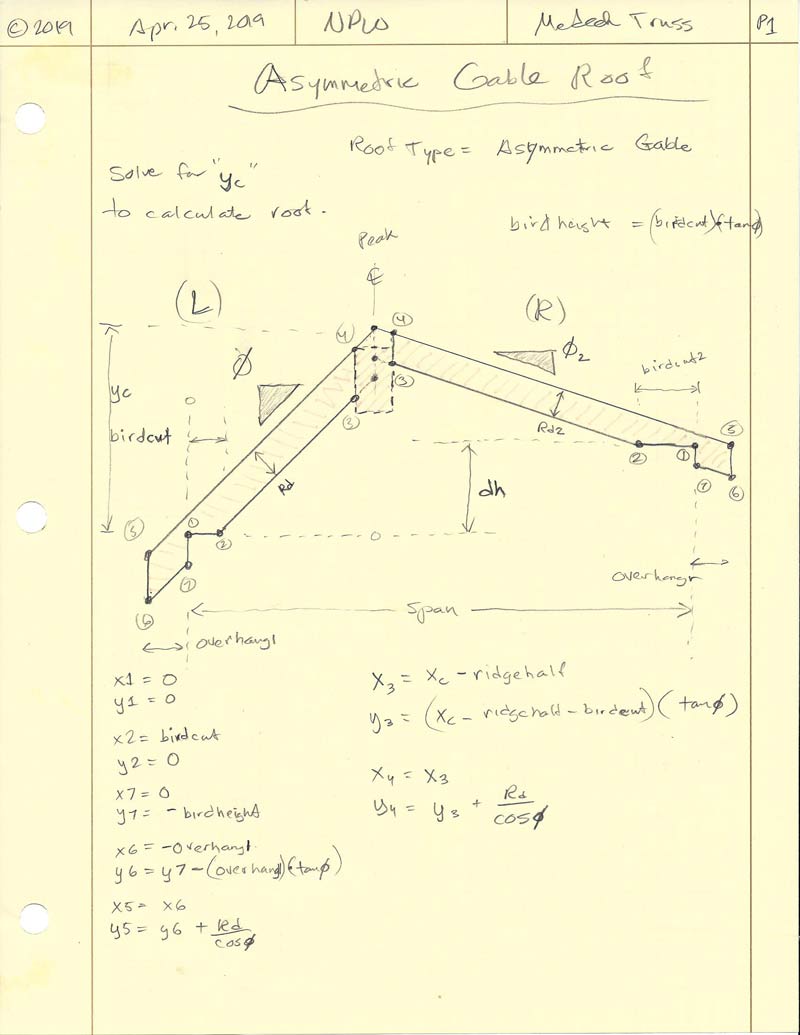

I won't really know if the math is correct until I drop it into the ruby code and test it.
I will also need to check for null solutions, where certain combinations of pitches and delta h create impossible geometry.
I kind of miss the rigor of the math often required with the development of the truss plugin. Asymmetric hip roofs are going to be even more math intensive.
I'm not exactly sure on what to do with the ridge board. I can either bevel it or drop it to the same height as the lower side rafters.
-
Version 2.3.5 - 04.28.2019
- Fixed the show_modal bug for macOS in the Materials tab of the global settings.
-
First look at an asymmetric roof:
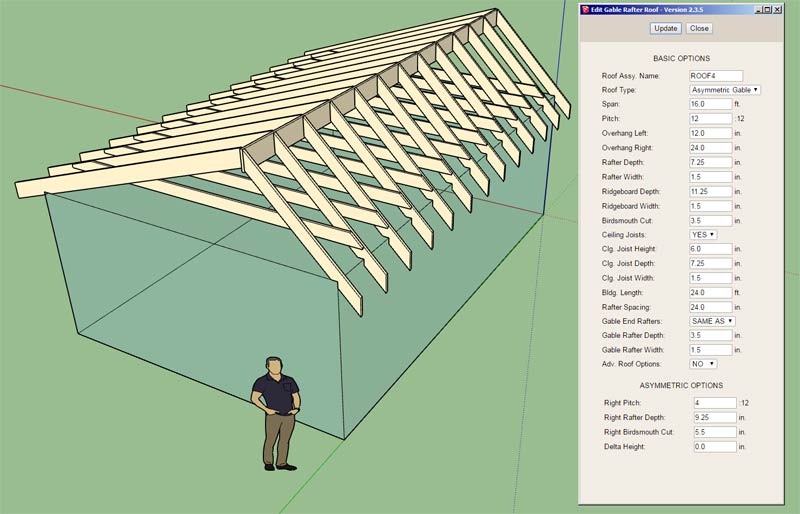
Note the addition of "Asymmetric Options" in the edit menu (4 parameters).
Also note that the rafter depth is different for each side of the roof as well as the birds mouth cut.
If the delta height is non-zero (can be either negative or positive) then I have the ceiling joists disabled for now. I will need some more direction with regard to that possible configuration.
I now just need to focus on the advanced options and bring them up to speed for an asymmetric gable roof (ie. gutters, hip and ridge, rake boards, sheathing, cladding etc...)
I've also spent some considerable time cleaning up the rafter roof module and re-organizing the file structure where it seemed prudent. The thing about these plugins is there is always more to do.
-
Version 2.3.6 - 05.01.2019
- Enabled asymmetric gable rafter roofs (imperial and metric units).
Tutorial 14: Asymmetric Gable Roofs
Sometimes you just never know until you dig into it. This latest update required a virtual rewrite of the entire rafter roof module. Asymmetric roofs literally change everything up. I'm glad to get this one wrapped up and behind me.
-
The asymmetric roof addition beat me up pretty hard for about three days, but in the end I won out. Now I need to look at the hip roof and how best to deal with multi pitches...
With the hip roof we are now talking about four different possible top plate heights with four different possible pitches, birdsmouth cuts, and rafter depths.
If one is to assume that the fascia boards all line up (gutters), then the top plates heights are actually driven by the roof overhang and the pitch of each roof plane. Only one roof plane (Plane A) will actually have its plate height set (the zero or base height of the roof), the other roof planes' top plate heights will be automatically calculated.
I suppose there is always the possibility where the fascia don't line up but I think this is more the exception than the rule, correct me if I am wrong.
As I've given this some more thought it occurred to me that typically the designer will set the roof pitches from the outset. Then, in order to get the fascia to line up, he/she can either adjust the overhang or the top plate height (assume that the birdsmouth cut is set to some value). So depending on the situation the user may want the plugin to calculate either the overhang (same top plate height) or the top plate height (same overhang). I will need to give this some more thought.
If the user keys in a numeric value for the overhang (roof planes B, C or D) then the edit menu can automatically set the delta height (top plate heights) for each respective roof plane to "AUTO". Likewise if a value is keyed in for the delta height the HTML form can set the respective overhang(s) to "AUTO".
-
I don't normally post on the boards regarding price changes in the plugins however I thought it might be worth noting that I have decreased the renewal price on the Truss plugin to $10.00. The idea being that once you have paid your initial license fee ongoing renewals are mostly a token payment.
-
Continuing on with regards to multi pitch hip roofs we need to be very clear about what point on the roof lines up when we talk about lining up the fascia. Do we mean the sub-fascia, rafter tail or the fascia?
Since I currently don’t have the fascia and soffit added yet I can probably ignore these for now and state that the top of the fascia board must line up with other fascia boards on other roof planes.
-
That make sense but in cutting rafters or fabricating trusses, isn't the only thing they can really do is line up the top of the rafter tails? Actually if there are tails, the truss manufacturer will leave it to the carpenter.
-
@pbacot said:
That make sense but in cutting rafters or fabricating trusses, isn't the only thing they can really do is line up the top of the rafter tails? Actually if there are tails, the truss manufacturer will leave it to the carpenter.
In the field I think its typical to provide rafter tails that are too long so that they can be trimmed all at once (chalk line) to ensure that they all line up.
-
I've got the asymmetric options added to the edit menu and the common rafters and fascia are calculating correctly:
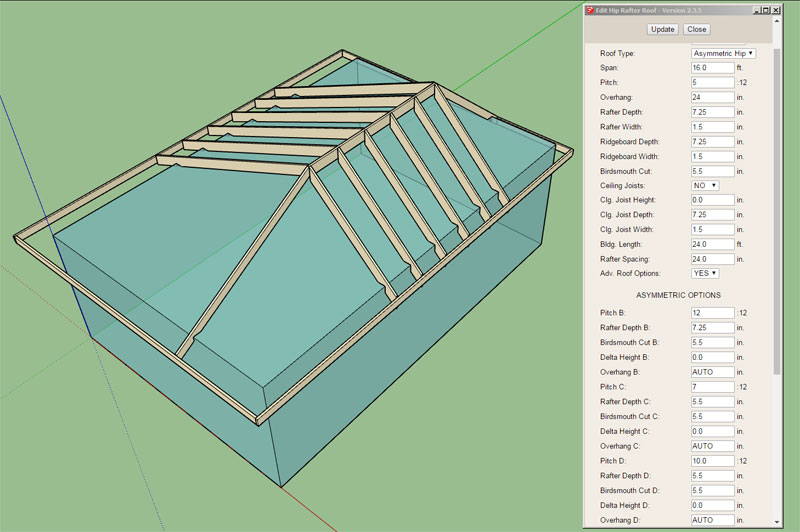
Note that all four pitches are different values, however the fascia lines up all the way around the roof as it should (in this case I have the overhangs auto calculating).
Next I will work on the hip rafters and jack rafters. As we can see in this example, all symmetry is broken, each hip rafter will be unique (x4) as well as each set of jack rafters (x8). Luckily we can program this sort of thing, drawing this type of roof manually would be a real headache.
-
First look at the sheathing and labels for an asymmetric hip roof:
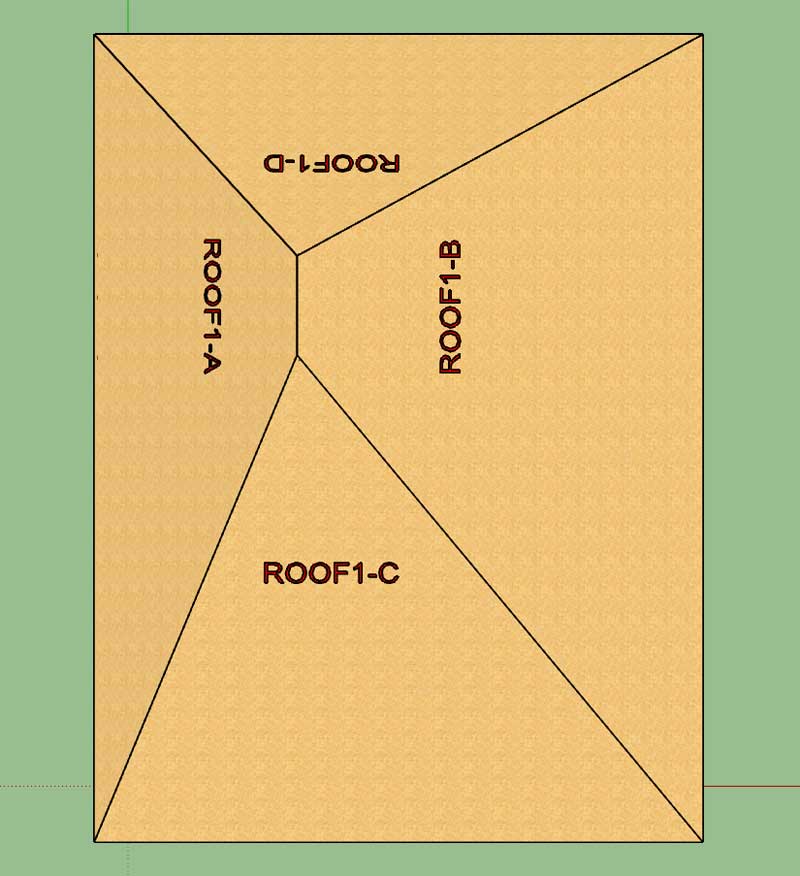
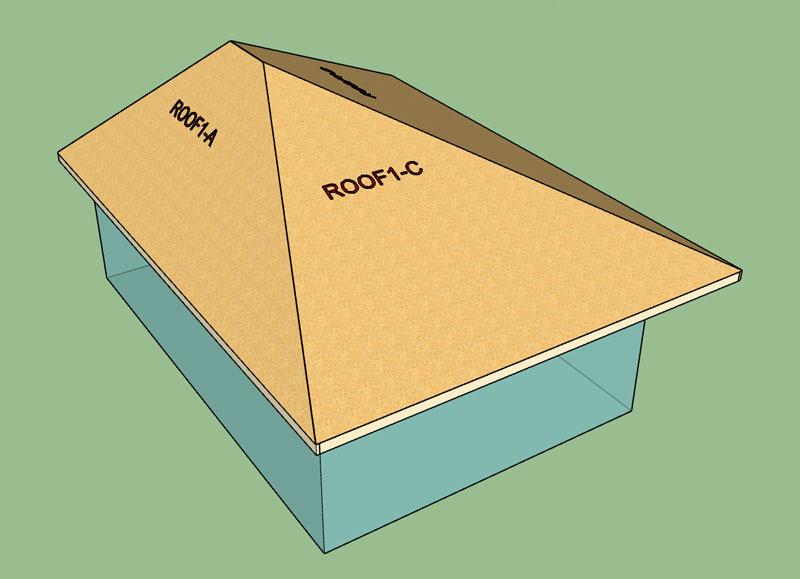
-
Pitch and SQFT callouts/labels are now working:
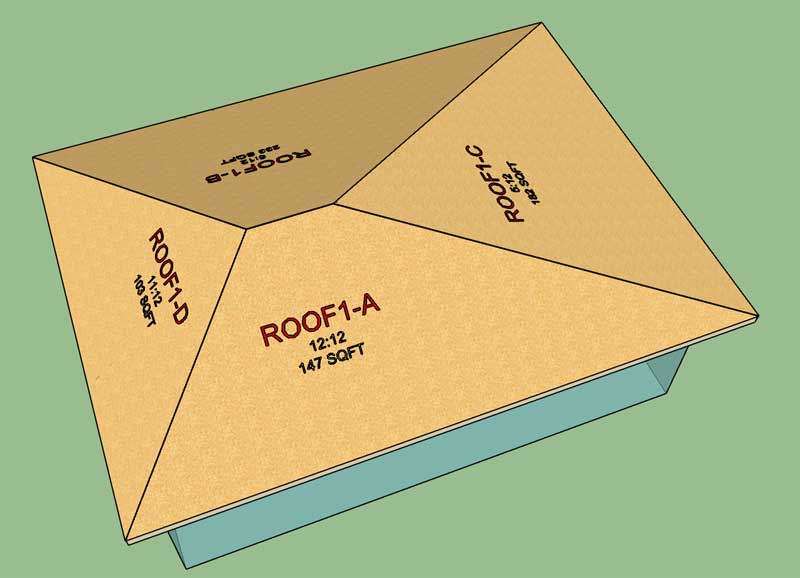
-
Hip and Ridge Cap is now working:
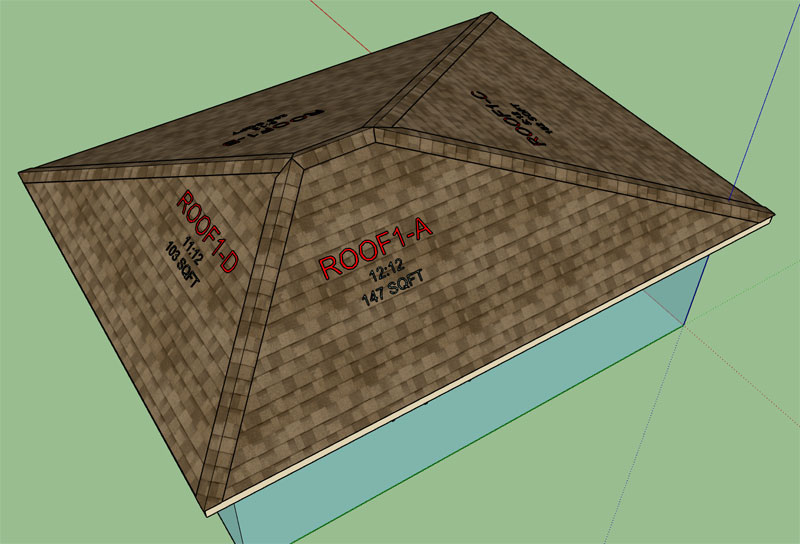
This chunk of code is just for the ridge cap geometry:
@Phi1_3 = atan(sin(@Phiplane13) * tan(@Phi) * cos(@Phihip13)) @Phi3_1 = atan(cos(@Phiplane13) * tan(@Phi3) * cos(@Phihip13)) @Phialpha1_3 = acos(cos(@Phihip13) * sin(@Phiplane13)) @Phialpha3_1 = acos(cos(@Phihip13) * cos(@Phiplane13)) @Psi1_3 = asin(0.70710678118 * sqrt(1.0 - cos(@Phi)*cos(@Phi3))) @Phi2_3 = atan(sin(@Phiplane23) * tan(@Phi2) * cos(@Phihip23)) @Phi3_2 = atan(cos(@Phiplane23) * tan(@Phi3) * cos(@Phihip23)) @Phialpha2_3 = acos(cos(@Phihip23) * sin(@Phiplane23)) @Phialpha3_2 = acos(cos(@Phihip23) * cos(@Phiplane23)) @Psi2_3 = asin(0.70710678118 * sqrt(1.0 - cos(@Phi2)*cos(@Phi3))) @Phi1_4 = atan(sin(@Phiplane14) * tan(@Phi) * cos(@Phihip14)) @Phi4_1 = atan(cos(@Phiplane14) * tan(@Phi4) * cos(@Phihip14)) @Phialpha1_4 = acos(cos(@Phihip14) * sin(@Phiplane14)) @Phialpha4_1 = acos(cos(@Phihip14) * cos(@Phiplane14)) @Psi1_4 = asin(0.70710678118 * sqrt(1.0 - cos(@Phi)*cos(@Phi4))) @Phi2_4 = atan(sin(@Phiplane24) * tan(@Phi2) * cos(@Phihip24)) @Phi4_2 = atan(cos(@Phiplane24) * tan(@Phi4) * cos(@Phihip24)) @Phialpha2_4 = acos(cos(@Phihip24) * sin(@Phiplane24)) @Phialpha4_2 = acos(cos(@Phihip24) * cos(@Phiplane24)) @Psi2_4 = asin(0.70710678118 * sqrt(1.0 - cos(@Phi2)*cos(@Phi4))) @Ridgex = (cos(@Phi)*@HRthk*tan((@Phi + @Phi2)*0.5)) - sin(@Phi) * @HRthk @Ridgey = (sin(@Phi)*@HRthk*tan((@Phi + @Phi2)*0.5)) + cos(@Phi) * @HRthk if @Sheathing_option == "YES" if @Roofbatten == "YES" if @Cboption == "YES" thtot = @Cbheight + @Battenheight + @Sheathing_thickness + @Roofcladding_thickness else thtot = @Battenheight + @Sheathing_thickness + @Roofcladding_thickness end else thtot = @Sheathing_thickness + @Roofcladding_thickness end else if @Roofbatten == "YES" if @Cboption == "YES" thtot = @Cbheight + @Battenheight + @Roofcladding_thickness else thtot = @Battenheight + @Roofcladding_thickness end else thtot = @Roofcladding_thickness end end # Extension at Peak @Wa3 = PI - (@Phialpha3_1 + @Phialpha3_2) @Beta23 = atan(sin(@Wa3)/(tan(@Psi1_3)/(tan(@Psi2_3)) + cos(@Wa3))) @Beta13 = @Wa3 - @Beta23 ext13 = (thtot * tan(@Psi1_3))/(tan(@Beta13)) ext23 = (thtot * tan(@Psi2_3))/(tan(@Beta23)) @Wa4 = PI - (@Phialpha4_1 + @Phialpha4_2) @Beta24 = atan(sin(@Wa4)/(tan(@Psi1_4)/(tan(@Psi2_4)) + cos(@Wa4))) @Beta14 = @Wa4 - @Beta24 ext14 = (thtot * tan(@Psi1_4))/(tan(@Beta14)) ext24 = (thtot * tan(@Psi2_4))/(tan(@Beta24)) # Ridge Length and Extensions ridgedx = (cos(@Phi)*thtot*tan((@Phi + @Phi2)*0.5)) ridgedy = (sin(@Phi)*thtot*tan((@Phi + @Phi2)*0.5)) length_sq = thtot**2 + ridgedx**2 + ridgedy**2 rext3 = sqrt(ext13**2 + (thtot/(cos(@Psi1_3)))**2 - length_sq) rext4 = sqrt(ext14**2 + (thtot/(cos(@Psi1_4)))**2 - length_sq) phicheck3 = atan(ext13*cos(@Psi1_3)/thtot) + PI - @Phihip13 phicheck4 = atan(ext14*cos(@Psi1_4)/thtot) + PI - @Phihip14 if phicheck3 > PI rext3 = -1.0 * rext3 end if phicheck4 > PI rext4 = -1.0 * rext4 end @Ridgecaplength = @Arraylength - @Hipf - @Hipb + rext3 + rext4 -
WOW.
I hope you never see a roof like this, but kudos for handling the situations where we may have a couple different pitches anyway.
-
Gutters and Downspouts are now functional for the Asymmetric Hip Rafter Roof:

Even with the different overhangs and top plate heights the gutter height (fascia) is the same height all the way around. However the downspouts on opposite sides of the roof are customized per the overhang on each respective side.
Tomorrow I will jump back into the hip and jack rafters and see if we can wrap this one up.
The good news is that the required code for the asymmetric hip and jacks already exists. I will be borrowing from the roof return module where I handled dissimilar pitches. The bad news is that after a cursory review of this block of code I have absolutely no idea how it actually works anymore (I haven't looked at it in about 2 years). It's just a matter of reverse engineering my own code for about an hour and it will all come back to me.
-
I'm actually still working on the hip rafters. The complexity of a multi-pitch roof took another unexpected turn with the realization that when roof planes A and B are different pitches it causes an offset in the rafters at the peak which requires some additional logic to account for this fact with the placement of the hip rafters and their geometry.
I'm also still a bit conflicted on how to best handle the birdsmouth cut of the hip rafters when they walls have different top plate heights. In some cases the hip rafter misses the corner entirely and is askew on one of the walls, this is the simple case. In other cases the hip rafter technically rests at the "corner" but since there are two different wall heights possible it is not clear how the birdsmouth cut should be constructed exactly. I'm assuming that the higher plate height will govern.
Does anyone have any photos or details of actual construction where a hip rafter bisects a corner where the top plate heights vary?
Advertisement







